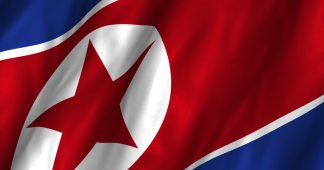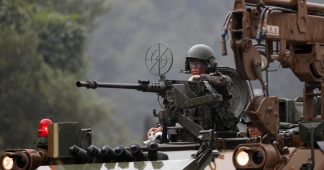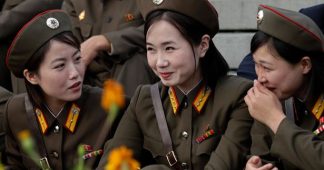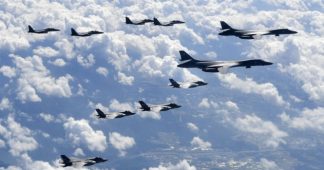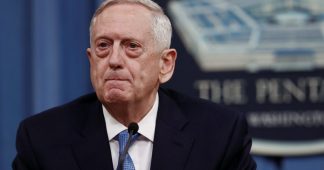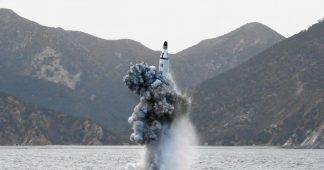State of Fear: How History’s Deadliest Bombing Campaign Created Today’s Crisis in Korea
As the world watches with mounting concern the growing tensions and bellicose rhetoric between the United States and North Korea, one of the most remarkable aspects of the situation is the absence of any public acknowledgement of the underlying reason for North Korean fears—or, as termed by United Nations Ambassador Nikki Haley, “state of paranoia”—namely, the horrific firebombing campaign waged by the U.S. Air Force during the Korean War and the unprecedented death toll that resulted from that bombing.
Although the full facts will never be known, the available evidence points toward the conclusion that the firebombing of North Korea’s cities, towns, and villages produced more civilian deaths than any other bombing campaign in history.
Historian Bruce Cumings describes the bombing campaign as “probably one of the worst episodes of unrestrained American violence against another people, but it’s certainly the one that the fewest Americans know about.”
The campaign, carried out from 1950 to 1953, killed 2 million North Koreans, according to General Curtis LeMay, the head of the Strategic Air Command and the organizer of the firebombing of Tokyo and other Japanese cities. In 1984, LeMay told the Office of Air Force History that the bombing of North Korea had “killed off 20 percent of the population.”
Other sources cite a somewhat lower number. According to a data set developed by researchers at the Centre for the Study of Civil War (CSCW) and the International Peace Research Institute, Oslo (PRIO), the “best estimate” of civilian deaths in North Korea is 995,000, with a low estimate of 645,000 and a high estimate of 1.5 million.
Though half of LeMay’s estimate, the CSCW/PRIO estimate of 995,000 deaths still exceeds the civilian death tolls of any other bombing campaign, including the Allied firebombing of German cities in World War II, which claimed an estimated 400,000 to 600,000 lives; the firebombing and nuclear bombing of Japanese cities, which caused an estimated 330,000 to 900,000 deaths; and the bombing of Indochina from 1964 to 1973, which caused an estimated 121,000 to 361,000 deaths overall during Operation Rolling Thunder, Operation Linebacker, and Operation Linebacker II (Vietnam); Operation Menu and Operation Freedom Deal (Cambodia), and Operation Barrel Roll (Laos).
The heavy death toll from the bombing of North Korea is especially notable in view of the relatively modest population of the country: just 9.7 million people in 1950. By comparison, there were 65 million people in Germany and 72 million people in Japan at the end of World War II.
The attacks by the U.S. Air Force against North Korea used the firebombing tactics that had been developed in the World War II bombing of Europe and Japan: explosives to break up buildings, napalm, and other incendiaries to ignite massive fires, and strafing to prevent fire-fighting crews from extinguishing the blazes.
The use of these tactics was not a foregone conclusion. According to United States policies in effect at the onset of the Korean War, firebombing directed at civilian populations was forbidden. A year earlier, in 1949, a series of U.S. Navy admirals had condemned such tactics in testimony before Congressional hearings. During this “Revolt of the Admirals,” the Navy had taken issue with their Air Force colleagues, contending that attacks carried out against civilian populations were counterproductive from a military perspective and violated global moral norms.
Coming at a time when the Nuremberg tribunals had heightened public awareness of war crimes, the criticisms of the Navy admirals found a sympathetic ear in the court of public opinion. Consequently, attacking civilian populations was forbidden as a matter of U.S. policy at the beginning of the Korean War. When Air Force General George E. Stratemeyer requested permission to use the same firebombing methods on five North Korean cities that “brought Japan to its knees,” General Douglas MacArthur denied the request, citing “general policy.”
Five months into the war, with Chinese forces having intervened on the side of North Korea and UN forces in retreat, General MacArthur changed his position, agreeing to General Stratemeyer’s request on November 3, 1950, to burn the North Korean city of Kanggye and several other towns: “Burn it if you so desire. Not only that, Strat, but burn and destroy as a lesson to any other of those towns that you consider of military value to the enemy.” The same evening, MacArthur’s chief of staff told Stratemeyer that the firebombing of Sinuiju had also been approved. In his diary, Stratemeyer summarized the instructions as follows: “Every installation, facility, and village in North Korea now becomes a military and tactical target.” Stratemeyer sent orders to the Fifth Air Force and Bomber Command to “destroy every means of communications and every installation, factory, city, and village.”
While the Air Force was blunt in its own internal communications about the nature of the bombing campaign—including maps showing the exact percentage of each city that had been incinerated—communications to the press described the bombing campaign as one directed solely at “enemy troop concentrations, supply dumps, war plants, and communication lines.”
The orders given to the Fifth Air Force were more clear: “Aircraft under Fifth Air Force control will destroy all other targets including all buildings capable of affording shelter.”
Within less than three weeks of the initial assault on Kanggye, ten cities had been burned, including Ch’osan (85%), Hoeryong (90%), Huich’on (75%), Kanggye (75%), Kointong (90%), Manp’ochin (95%), Namsi (90%), Sakchu (75%), Sinuichu (60%), and Uichu (20%).
On November 17, 1950, General MacArthur told U.S. Ambassador to Korea John J. Muccio, “Unfortunately, this area will be left a desert.” By “this area” MacArthur meant the entire area between “our present positions and the border.”
As the Air Force continued burning cities, it kept careful track of the resulting levels of destruction:
* Anju – 15%
* Chinnampo (Namp’o)- 80%
* Chongju (Chŏngju) – 60%
* Haeju – 75%
* Hamhung (Hamhŭng) – 80%
* Hungnam (Hŭngnam) – 85%
* Hwangju (Hwangju County) – 97%
* Kanggye – 60% (reduced from previous estimate of 75%)
* Kunu-ri (Kunu-dong)- 100%
*Kyomipo (Songnim) – 80%
* Musan – 5%
* Najin (Rashin) – 5%
* Pyongyang – 75%
* Sariwon (Sariwŏn) – 95%
* Sinanju – 100%
* Sinuiju – 50%
* Songjin (Kimchaek) – 50%
* Sunan (Sunan-guyok) – 90%
* Unggi (Sonbong County) – 5%
* Wonsan (Wŏnsan)- 80%
In May 1951, an international fact-finding team stated, “The members, in the whole course of their journey, did not see one town that had not been destroyed, and there were very few undamaged villages.”
On June 25, 1951, General O’Donnell, commander of the Far Eastern Air Force Bomber Command, testified in answer to a question from Senator Stennis (“…North Korea has been virtually destroyed, hasn’t it?):
“Oh, yes; … I would say that the entire, almost the entire Korean Peninsula is just a terrible mess. Everything is destroyed. There is nothing standing worthy of the name … Just before the Chinese came in we were grounded. There were no more targets in Korea.”
In August 1951, war correspondent Tibor Meray stated that he had witnessed “a complete devastation between the Yalu River and the capital.” He said that there were “no more cities in North Korea.” He added, “My impression was that I am traveling on the moon because there was only devastation…. [E]very city was a collection of chimneys.”
Several factors combined to intensify the deadliness of the firebombing attacks. As had been learned in World War II, incendiary attacks could devastate cities with incredible speed: the Royal Air Force’s firebombing attack on Würzburg, Germany, in the closing months of World War II had required only 20 minutes to envelop the city in a firestorm with temperatures estimated at 1500–2000°C.
Another factor contributing to the deadliness of attacks was the severity of North Korea’s winter. In Pyongyang, the average low temperature in January is 8° Fahrenheit. Since the most severe bombing took place in November 1950, those who escaped immediate death by fire were left at risk of death by exposure in the days and months that followed. Survivors created makeshift shelters in canyons, caves, or abandoned cellars. In May 1951 a visiting delegation to the bombed city of Sinuiju from the Women’s International Democratic Federation (WIDF) reported:
“The overwhelming majority of the inhabitants live in dug-outs made of earth supported from salvaged timber. Some of these dug-outs have roofs made of tiles and timber, salvaged from destroyed buildings. Others are living in cellars that remained after the bombardment and still others in thatched tents with the frame-work of destroyed buildings and in huts made of unmortared brick and rubble.”
In Pyongyang, the delegation described a family of five members, including a three-year-old child and an eight-month-old infant, living in an underground space measuring two square meters that could only be entered by crawling through a three-meter tunnel.
A third deadly factor was the extensive use of napalm. Developed at Harvard University in 1942, the sticky, flammable substance was first used in War War II. It became a key weapon during the Korean War, in which 32,557 tons were used, under a logic that historian Bruce Cumings characterized: “They are savages, so that gives us the right to shower napalm on innocents.” Long after the war, Cumings described an encounter with one aging survivor:
“On a street corner stood a man (I think it was a man or a woman with broad shoulders) who had a peculiar purple crust on every visible part of his skin—thick on his hands, thin on his arms, fully covering his entire head and face. He was bald, he had no ears or lips, and his eyes, lacking lids, were a grayish white, with no pupils…. [T]his purplish crust resulted from a drenching with napalm, after which the untreated victim’s body was left to somehow cure itself.”
During armistice talks at the conclusion of the fighting, U.S. commanders had run out of cities and towns to target. In order to place pressure on the negotiations, they now turned the bombers toward Korea’s major dams. As reported in New York Times, the flood from the destruction of one dam “scooped clean” twenty-seven miles of river valley and destroyed thousands of acres of newly planted rice.
In the wake of the firebombing campaigns against Germany and Japan during World War II, a Pentagon research group comprising 1,000 members carried out an exhaustive assessment known as the United States Strategic Bombing Survey. The USSBS released 208 volumes for Europe and 108 volumes for Japan and the Pacific, including casualty counts, interviews with survivors, and economic surveys. These industry-by-industry reports were so detailed that General Motors used the results to successfully sue the U.S. government for $32 million in damages to its German plants.
After the Korean War, no survey of the bombing was done other than the Air Force’s own internal maps showing city-by-city destruction. These maps were kept secret for the next twenty years. By the time the maps were quietly declassified in 1973, America’s interest in the Korean War had long since faded. Only in recent years has the full picture begun to emerge in studies by historians such as Taewoo Kim of the Korea Institute for Defense Analyses, Conrad Crane of the U.S. Military Academy, and Su-kyoung Hwang of the University of Pennsylvania.
In North Korea, the memory of lives on. According to historian Bruce Cumings, “It was the first thing my guide brought up with me.” Cumings writes: “The unhindered machinery of incendiary bombing was visited on the North for three years, yielding a wasteland and a surviving mole people who had learned to love the shelter of caves, mountains, tunnels and redoubts, a subterranean world that became the basis for reconstructing a country and a memento for building a fierce hatred through the ranks of the population.”
To this day, the firebombing of North Korea’s cities, towns, and villages remains virtually unknown to the general public and unacknowledged in media discussions of the crisis, despite the obvious relevance to North Korea’s pursuit of a nuclear deterrent. Yet without knowing and confronting these facts, the American public cannot begin to comprehend the fear that lies at the heart of North Korean attitudes and actions.
